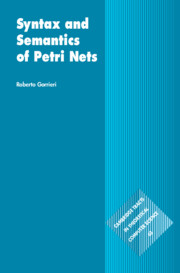Refine search
Actions for selected content:
6950 results in Algorithmics, Complexity, Computer Algebra, Computational Geometry
4 - Communicating Systems
-
- Book:
- Syntax and Semantics of Petri Nets
- Published online:
- 09 September 2025
- Print publication:
- 25 September 2025, pp 105-199
-
- Chapter
- Export citation
Glossary
-
- Book:
- Syntax and Semantics of Petri Nets
- Published online:
- 09 September 2025
- Print publication:
- 25 September 2025, pp 253-257
-
- Chapter
- Export citation
Preface
-
- Book:
- Syntax and Semantics of Petri Nets
- Published online:
- 09 September 2025
- Print publication:
- 25 September 2025, pp vii-vii
-
- Chapter
- Export citation
1 - Introduction
-
- Book:
- Syntax and Semantics of Petri Nets
- Published online:
- 09 September 2025
- Print publication:
- 25 September 2025, pp 1-10
-
- Chapter
- Export citation
6 - Conclusion
-
- Book:
- Syntax and Semantics of Petri Nets
- Published online:
- 09 September 2025
- Print publication:
- 25 September 2025, pp 229-234
-
- Chapter
- Export citation
References
-
- Book:
- Syntax and Semantics of Petri Nets
- Published online:
- 09 September 2025
- Print publication:
- 25 September 2025, pp 258-265
-
- Chapter
- Export citation
3 - Non-communicating Parallel Systems
-
- Book:
- Syntax and Semantics of Petri Nets
- Published online:
- 09 September 2025
- Print publication:
- 25 September 2025, pp 58-104
-
- Chapter
- Export citation
Appendix - Solutions to Selected Exercises
-
- Book:
- Syntax and Semantics of Petri Nets
- Published online:
- 09 September 2025
- Print publication:
- 25 September 2025, pp 235-252
-
- Chapter
- Export citation
Index
-
- Book:
- Syntax and Semantics of Petri Nets
- Published online:
- 09 September 2025
- Print publication:
- 25 September 2025, pp 266-270
-
- Chapter
- Export citation
2 - Sequential Systems
-
- Book:
- Syntax and Semantics of Petri Nets
- Published online:
- 09 September 2025
- Print publication:
- 25 September 2025, pp 11-57
-
- Chapter
- Export citation
Contents
-
- Book:
- Syntax and Semantics of Petri Nets
- Published online:
- 09 September 2025
- Print publication:
- 25 September 2025, pp v-vi
-
- Chapter
- Export citation
Frontmatter
-
- Book:
- Syntax and Semantics of Petri Nets
- Published online:
- 09 September 2025
- Print publication:
- 25 September 2025, pp i-iv
-
- Chapter
- Export citation
Acknowledgments
-
- Book:
- Syntax and Semantics of Petri Nets
- Published online:
- 09 September 2025
- Print publication:
- 25 September 2025, pp viii-x
-
- Chapter
- Export citation
Comparing the sets of volume polynomials and Lorentzian polynomials
- Part of
-
- Journal:
- Combinatorics, Probability and Computing , First View
- Published online by Cambridge University Press:
- 19 September 2025, pp. 1-14
-
- Article
-
- You have access
- Open access
- HTML
- Export citation
Glauber dynamics for the hard-core model on bounded-degree
 $H$-free graphs
$H$-free graphs
- Part of
-
- Journal:
- Combinatorics, Probability and Computing / Volume 34 / Issue 6 / November 2025
- Published online by Cambridge University Press:
- 19 September 2025, pp. 803-814
-
- Article
-
- You have access
- Open access
- HTML
- Export citation
An explicit economical additive basis
- Part of
-
- Journal:
- Combinatorics, Probability and Computing / Volume 34 / Issue 6 / November 2025
- Published online by Cambridge University Press:
- 12 September 2025, pp. 815-820
-
- Article
-
- You have access
- Open access
- HTML
- Export citation

Syntax and Semantics of Petri Nets
-
- Published online:
- 09 September 2025
- Print publication:
- 25 September 2025
Proper minor-closed classes of graphs have Assouad–Nagata dimension 2
- Part of
-
- Journal:
- Combinatorics, Probability and Computing , First View
- Published online by Cambridge University Press:
- 09 September 2025, pp. 1-25
-
- Article
-
- You have access
- Open access
- HTML
- Export citation
On approximability of satisfiable
 $\boldsymbol {k}$-CSPs: II
$\boldsymbol {k}$-CSPs: II
-
- Journal:
- Combinatorics, Probability and Computing / Volume 34 / Issue 6 / November 2025
- Published online by Cambridge University Press:
- 20 August 2025, pp. 857-926
-
- Article
- Export citation
Embedding nearly spanning trees
- Part of
-
- Journal:
- Combinatorics, Probability and Computing / Volume 34 / Issue 6 / November 2025
- Published online by Cambridge University Press:
- 11 August 2025, pp. 927-931
-
- Article
- Export citation















































































